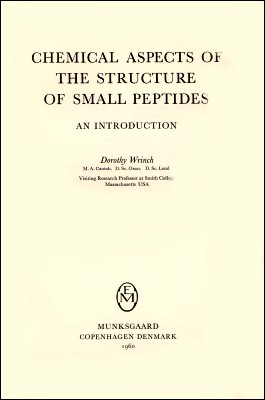Dorothy Wrinch
Chemical Aspects of the Structure of Small Peptides: An Introduction
Munksgaard, Copenhagen Denmark, 1960

Table of Contents
- From the globular proteins to small peptides
- The problem of finding structures for the globular proteins
- Small peptides as today's focus in the organic chemical approach to peptide structure
- The cyclol structure for the peptide moiety of five ergot alkaloids
- The 'Asp.Lys' dipeptide containing a multiple peptide grouping
- Model molecules containing multiple peptide groupings
- Ideas of the amide and cyclol systems
- An organic chemical formulation of the amide and cyclol theories
- The amide hypothesis
- The cyclol hypothesis as a generalization of the amide hypothesis
- Characteristics of the multiple peptide groupings
- Forms assumed by the monomers in the amide and cyclol systems
- A comparison with the original formulation of the cyclol theory
- Hydrogen bridges within amide and cyclol structures
- Hydrogen bridge systems suggested by the cyclol hypothesis
- The two types of structure for peptides within the amide system
- The R-compositions and R-constitutions of polypeptide chains
- Degenerations of polypeptide chains and possible secondary syntheses
- Some peptides containing cyclol groupings, and their degenerations
- The significance of polypeptide chains as degradation products of peptides
- Some double α-monomers
- The α-imino acids obtained from peptides, and their homologues
- The α,ω monomers and ω- and ω,ω'-monomers obtained from peptides, and their homologues
- The extended amide hypothesis and branched polypeptide chains
- Amide groupings containing C-N bonds of the four different kinds
- The extended cyclol hypothesis in parallel with the extended amide hypothesis
- Some structural fragments in α,ω-peptides
- Imbalances of α- and ω-NH2 groups and α- and ω-COOH groups in peptides
- The varying interpretations of data afforded b the amide and cyclol systems
- Some structural features of bacitracin A
- A branch point at the phenylalanine monomer?
- The bonds uniting the lysine and aspartic acid monomers
- The generalized peptide groupings in a wider context
- The special character of the two-bond peptide groupings
- Amine and carboxyl transfers
- Two-bond peptide groupings as intermediates in certain enzymic reactions?
- Other two-bond groupings as intermediates in some enzymic reactions
- The 'non-peptide' grouping in gramicidin
- How can labile groupings be stabilized
- The place in organic chemistry of the multiple peptide groupings
Appendix A. Certain ortho groupings and related multiple groupings
Appendix B. Excerpts from the Works of Emil Fischer
- Structures for small peptides within the amide and cyclol systems
- Introduction
- Structure types for small α-peptides
- Some structure types for tripeptides
- Some structure types for tetrapeptides
- Degeneration products of tripeptides and tetrapeptides
- Certain issues introduced by the cyclol structures
- Some general considerations
- A few structure types for pentapeptides
- Intermolecular proton migrations and the formation of larger peptides
- Some hydrogen-bridged dimers and trimers and other oligomers
- The R-compositions and R-constitutions of a peptide with a structure of given type
- The bearing of the R-constitutions of peptides on routes of degeneration
- The embedding of a hydantoin or piperazine ring in peptide structures
- On the significance of degradation products containing hydantoin or piperazine rings
- The history of the ergot tripeptide structure
- The occasion for the new structure
- The reductive cleavage of the tripeptides
- The investigation of the tripeptides by high temperature cleavage
- The conditioned stability of the new structure
- Stabilizing factors in the tripeptide structures
- Limitations in hydrolytic degradation studies
- Determining the L- or D-forms of the monomers in peptides
- A change in chemical constitution or a superposed 'fine structure'?
- Growing points in peptides studies
- Introduction
- Peptides as an expression of the nature of their monomers
- The broader viewpoint regarding peptide groupings
- Other issues
- Developments suggested by the researches on the ergot tripeptides
- Double α-monomers and the penicillin structures
- The trend towards structures of higher connexity
- Model molecules suggested by 'Asp.Lys'
- The bearing of 'Asp.Lys' on the structure of bacitracin A
- A polycyclic structure for bacitracin A?
- 'Asp.Lys' as one of a set of α,ω-dipeptides
- Towards the synthesis of multiple peptide groupings by transannular interactions
